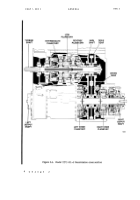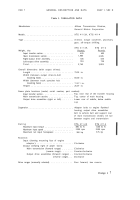TM-9-2520-234-35 - Page 42 of 323
CHAP 2, SEC II
DESCRIPTION AND OPERATION OF
PAR 11-13
MAIN TRANSMISSION ASSEMBLY
66 push piston assembly 67 into housing
assembly 73, allowing the clutch plates to
separate and slip freely.
(3) The governor is a “fluid velo-
city” type. The governor ring, riveted or
welded to the left end of housing 73, is kept
filled with oil, retained in the ring by
centrifugal force during rotation. The oil
thus moves at virtually the same speed as
does the ring. The pitot tube 76 is posi-
tioned so that its open end faces against
the movement of the oil in the governor
ring. The opposite end of the pitot tube
connects with the hydraulic control sys-
tem .
Pressure in the governor line thus
varies with the speed at which oil is thrown
into the pitot tube by the rotating ring.
12.
INTERMEDIATE-RANGE
CLUTCH
AND PLANETARY GEARING
a. Intermediate-range Clutch
Components (fig. 376, fold-out 5)
(1) Intermediate-range clutch in-
cludes a clutch housing 3, four internal-
splined 4 and three external-splined 5
plates, apply plate 7, spring 8 piston 9 and
piston housing 14. External splines on ring
gear assembly 6 serve as the clutch hub.
(2) Clutch housing 3 is anchored,
against rotation, in the transmission hous-
ing. Plates 5 and apply plate 7 engage
slots in housing 3. Plates 4 engage exter-
nal splines on ring gear assembly 6. Pis-
ton housing 14 is anchored in transmission
housing by bolt 42 (fig. 375, fold-out 4).
Piston 9 (fig. 376, fold-out 5) works in a
bore of housing 14 on ring seals 11 and 12.
b .
—
Intermediate-range Planetary
Gearing Components (fig. 376,
fold-out 5)
(1) Planetary gearing for thi s
range includes carrier 18, four 18-tooth
pinions 22, spindles 19, a 36-tooth sun gear
61 (fig. 375, fold-out 4) and a 72-tooth
ring gear assembly 6 (fig. 376, fold-out 5).
(2) Pinions 22 or 64 rotate on
bearings 23 or 65 and are supported by
spindles 19 in the carrier. Sun gear 61
(fig. 375, fold-out 4) is splined to turbine
shaft 2. Ring gear 6 (fig. 376, fold-out 5)
has internal teeth and external splines.
Carrier 18 is supported by bearing 55 (fig.
375, fold-out 4) at one end and is splined
to low-range ring gear 38 (fig. 376, fold-
out 5) at the opposite end.
c . Operation of Intermediate-range
Clutch and Planetary Gearing
(fig. 376, fold-out 5)
(1) When hydraulic pressure is
directed to the cavity between piston 9
and housing 14, the piston moves against
spring 8 and apply plate 7 and compresses
internal-splined 4 and external-splined 5
plates against housing 3. This locks ring
gear assembly 6 against rotation. Sun gear
61 (fig. 375, fold-out 4) is the driving
member of the planetary. Its rotation
drives pinions 22 or 64 (fig. 376, fold-out
5) counterclockwise (viewed from left of
transmission) while causing carrier 18 to
rotate clockwise. Stationary ring gear
assembly 6 is the reaction member and
carrier 18 is the driven member.
(2) When hydraulic pressure is ex-
hausted from the clutch cavity, spring 8
pushes piston 9 into housing 14. This allows
the clutch plates to separate and have
running clearance, releasing the clutch.
(3) The intermediate-range plan-
etary gearing is compounded with the low-
range planetary gearing to obtain the de-
sired ratio. The rotation of carrier 18 is
imparted to low-range ring gear 38. Low-
range sun gear 62 (fig. 375, fold-out 4) is
splined to the same shaft as is intermedi-
ate-range sun gear 61. Thus, the rotations,
at different speeds, of ring gear 38 (fig.
376, fold-out 5) and sun gear 62 (fig. 375,
fold-out 4) impart rotation to the low-
range shaft and carrier which is the trans-
mission out put shaft. The resulting com-
bined reduction of the two planetar y
systems is 2 to 1.
13. LOW-RANGE CLUTCH AND
PLANETARY GEARING
a.
clutch
Low-range Clutch Components
(fig. 376, fold-out 5)
(1) The low-range clutch includes
housing 44, four internal -splined
14 Change 2
Back to Top




















